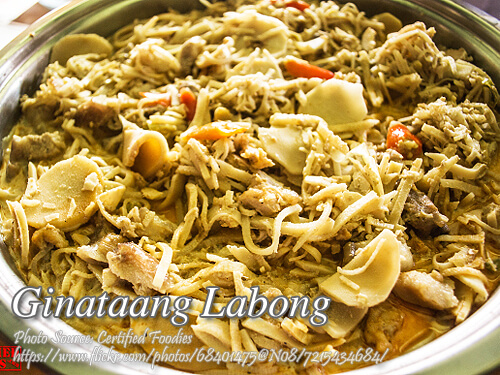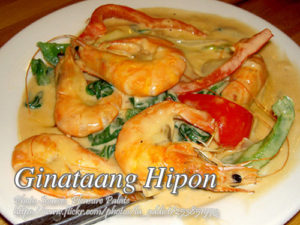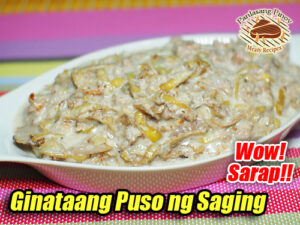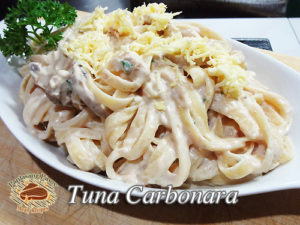Ginataang labong is vegetable dish which is a simple to cook bamboo shoots with coconut cream. Buying fresh and good quality bamboo shoots is bit tricky because you usually don’t know how it is prepared commercially when sold in supermarkets or wet markets. If not properly prepared, they will have a foul odor. Some vendors just put them in dirty tin cans which contaminates the bamboo shoots.
Aside from that, you also have to know if those are really young and tender shoots because some vendors sell them even though they are very tough, it’s like you are eating wood shavings. And about the coconut cream, the method in the recipe below is that traditional way of extracting cream but you can use canned coconut cream.
Ginataang Labong: A Taste of Home and Heritage
I remember the first time I truly fell in love with ginataang labong—the fragrant, hearty dish of tender bamboo shoots cooked in rich coconut cream. It was a rainy afternoon in my hometown, and my Tita Liza was busy preparing lunch. The entire kitchen was wrapped in the scent of coconut cream gently bubbling in a pot, mingling with the aroma of ginger and garlic. I sat there, mesmerized, as she worked her magic. Little did I know that years later, I’d be trying to recreate that very same dish, armed with stories from my family and techniques passed down from one generation to the next.
Choosing the Best Bamboo Shoots for Ginataang Labong
Cooking ginataang labong begins with choosing the right bamboo shoots, or labong, as we fondly call them in the Philippines. This step might seem simple, but according to my Uncle Jaime, who spent much of his youth farming in Nueva Ecija, the secret to a perfect dish lies in selecting young and tender shoots. Fresh bamboo shoots should have a mild, earthy aroma and feel firm yet delicate to the touch.
Uncle Jaime always emphasized that overly mature bamboo shoots can turn a hearty meal into a mouthful of what feels like shredded wood. He would joke about the time he accidentally used tough labong and ended up with a dish only the family goats would appreciate. And trust me, you don’t want that experience!
Prepping Bamboo Shoots the Right Way
Once you’ve secured your fresh, tender bamboo shoots, prepping them properly is crucial. My cousin Mika, who studied culinary arts, explained to me why soaking labong in water is non-negotiable. Bamboo shoots naturally contain cyanogenic compounds, which can cause a mildly bitter and astringent flavor if not handled correctly. Soaking them for an hour helps leach out any bitterness, resulting in a milder, more pleasant taste. After soaking, draining and squeezing out excess water ensures the bamboo shoots don’t dilute the dish’s creamy sauce.
Extracting Fresh Coconut Cream
Coconut cream is the heart of ginataang labong. My Lola Nena, the queen of all things ginataan, used to say that nothing beats the creamy, luscious taste of freshly squeezed coconut cream. Sure, you can use canned cream for convenience, but if you’re aiming for authenticity, it’s worth the effort to extract it the traditional way. The method Lola taught me involves adding lukewarm water to freshly grated coconut, squeezing it with your hands, and then straining it through a cheesecloth.
The first extraction, called kakang gata, is thick and luscious. It adds a velvety richness to the dish. The second extraction, which is thinner, is used to simmer the ingredients and infuse them with the coconut’s subtle sweetness. As the sauce thickens, it coats the bamboo shoots, pork, and shrimp, creating a harmonious blend of flavors.
Building Layers of Flavor for Ginataang Labong
As with many Filipino recipes, ginataang labong begins with a flavorful gisa base. I remember my older brother Marco, who spent a year living in Bicol, teaching me the importance of sautéing ginger, garlic, and onions until they release their fragrance. The ginger, he explained, not only adds a warm, peppery note but also helps mask any residual earthiness in the bamboo shoots. Meanwhile, garlic and onion bring out a sweet and savory depth to the dish, rounding out the flavors beautifully.
Adding pork and shrimp transforms this simple vegetable dish into a filling, mouthwatering meal. The fat from the pork enriches the coconut cream, while the shrimp lends a subtle brininess that perfectly complements the sweetness of the sauce. If you prefer a vegetarian version, you can skip the meat, but trust me, there’s something undeniably comforting about the interplay between all these ingredients.
The Perfect Simmer and Spice
After the base ingredients are combined and the second extraction of coconut milk is added, the dish needs time to simmer. This gentle cooking allows the flavors to meld together, turning the bamboo shoots tender and flavorful. My Tito Boy always said that patience is key. “Good things come to those who wait,” he’d joke, while peeking into the pot. And he was right. Letting the dish simmer ensures that every ingredient soaks up the coconut’s creamy goodness.
Once the bamboo shoots are nearly done, it’s time to add the kakang gata. This thick, rich coconut cream transforms the sauce, giving it a velvety finish. And don’t forget the green finger chili! I learned from my cousin Ana, who loves her food with a kick, that adding the chili at the end preserves its heat. For a spicier dish, mince the chilies and watch as the sauce takes on a fiery depth that’ll make you crave more.
A Bite of Filipino Heritage
As you savor ginataang labong, you’re not just enjoying a delicious meal. You’re tasting a piece of Filipino heritage, a tradition passed down from kitchens where stories, laughter, and the comforting aroma of coconut cream fill the air. It’s a dish that speaks of family, of rainy afternoons with loved ones, and of the magic that happens when simple, humble ingredients come together.
Food for thought: Bamboo shoots have been a part of Southeast Asian cuisine for centuries. Aside from being delicious, they’re packed with nutrients like fiber, potassium, and antioxidants. It’s amazing how a single ingredient, often overlooked, has the power to bring families together around the table.
How to Cook Ginataang Labong:
Ingredients
- 2 cups bamboo shoots strips
- 1 pc big mature coconut grated
- 100 grams small fresh shrimps peeled
- 100 grams pork belly cut into small cubes
- 2 pcs siling haba finger chili
- 1 large onion chopped
- 3 cloves garlic minced
- 1 Tbsp. ginger minced
- 1 tsp. MSG or granulated seasoning
- salt to taste
Instructions
How to cook ginataang labong:
- Soak labong in water for one hour. Drain. Squeeze out the water and set aside.
- Add a cup of lukewarm water to the grated coconut, squeeze with your hands and fingers until the coconut milk comes out from the grated coconut.
- Extract the milk by squeezing the grated coconut on a sieve or cheese cloth and pour it into a bowl. Set aside.
- Make a second extraction by pouring 2 cups of water on the grated coconut and squeeze again and strain the grated coconut using a cheese cloth and squeeze directly on the pan or pot.
- Then add ginger, garlic, onion, pork, shrimps, pepper and seasoning.
- Bring to a boil while stirring gently. After 3 minutes of boiling, add the bamboo shoots. Cover and simmer for about 10 minutes.
- Then add the thick coconut cream, simmer until bamboo shoots is done and the sauce is thick.
- Add the green finger chili 2 minutes before the cooking is done. You can also mince the chilies if you want the dish hot and spicy.
Notes
Cooking Tips:
Mastering the Bamboo Shoot Soaking Technique
To ensure that your dish is a culinary triumph, start with the bamboo shoots. Soak them in water for at least an hour, allowing any impurities to be washed away. This step not only cleans the shoots but also plays a crucial role in assessing their tenderness. A well-soaked bamboo shoot contributes to the dish's overall texture, ensuring a delightful eating experience.Elevate Flavor with Homemade Coconut Cream
While canned coconut cream is a convenient option, consider embracing the traditional method of coconut cream extraction for an authentic taste. Squeezing the grated coconut by hand adds a personal touch to your dish and allows you to control the thickness of the coconut cream. This extra effort pays off in the final result, as the homemade coconut cream becomes the soul of your dish, enhancing its richness and depth of flavor.Timing is Key in the Flavor Fusion Process
Achieving the perfect harmony of flavors in the dish requires careful timing during the cooking process. After adding the bamboo shoots to the pot, let them simmer for around 10 minutes. This allows ample time for the shoots to absorb the essence of the coconut cream and the other aromatic ingredients. Additionally, introducing the thick coconut cream at the right moment ensures that it melds seamlessly with the bamboo shoots, creating a luscious and well-balanced sauce. Pay attention to the timing, and you'll be rewarded with a dish that captivates the taste buds with every spoonful.





